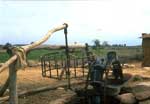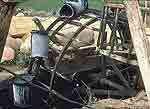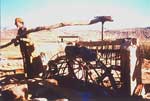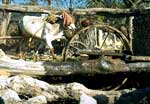 | |  | |  |
| |
Iron noria Marrakesh, Morocco
The iron noria is an accurate copy of the device in wood. The construction looks rather old-fashioned but this was in use up to 1990.
[99] | | Iron noria, Morocco
The bucket for the pot garland has a long history. In Early Roman times the bucket was made of leather or wood. During the Late Roman period it was made of pottery. After this time sheet metal and finally rubber were used.
[100] | | Iron noria, Morocco
Same subject as in [100]. The rubber bucket is made of a salvaged car tyre.
[139] |
|
 | |  | |  |
| |
Iron noria, Morocco
More or less the same construction as in [100]. Our taxi-driver is pushing the draw bar to demonstrate how the noria works.
[101] | | Iron noria, Morocco
It can be seen that the man is walking in a counterclockwise direction. This is the correct way in the Islamic World. We have the same "direction" for the pilgrims walking round the Kaba in Mecca.
[102] | | Water-lifting device in Pakistan
This construction is a copy of the former made in wood. If we compare different methods of harnessing to this sort of device, the solution from Pakistan is the best one. Here a zebu-ox is fitted with a pad, which distributes the force to the shoulders of the ox. From here, the pull goes down at an angle and then horizontally. The zebu is a powerful animal, which can walk quite fast. It is my impression that this device has an output of about 150 watt.
[135] |
|
 | |  | | |
| |
Iron wheel in Pakistan
These pots are very small but on the other hand, there are many of them. Here the term ‘pot-garland’ is very appropriate, as the pots are arranged close to each other, like a string of pearls. Many but small are far better than few and big.
[136] | | The same wheel as in [136]
If the well is not deep, this pot-garland can lift a huge amount of water. The flow is greater than the amount of water coming from ten domestic taps.
[137] | | |
|